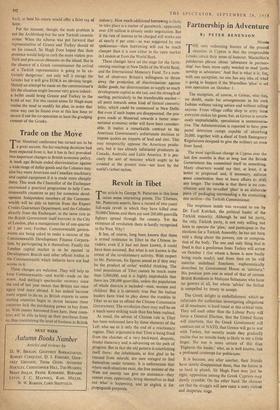Revolt' in Tibet
rr HE article by George N. Patterson in this issue 1 raises some interesting points. The Tibetans, Mr. Patterson asserts, have a record of two years' full-scale revolt in which they have killed over 50,000 Chinese, and there are now 200,000 guerrilla fighters spread through the country. Yet the existence of revolution there is hardly recognised in the West. Why?
It has, of course, long been known that there is armed resistance in Tibet to the Chinese in- vaders; even if it had not been known, it could have been assumed. But what is not known is the extent of the revolutionary activity. With respect to Mr. Patterson, his figures sound as if they may be the product of exiles' wishful thinking. The total population of Tibet cannot be much more than 5,000,000, and it is highly improbable that there are 200,000 guerrillas, unless the population of whole districts is included—men, women and children. But it is certainly true that the Indian leaders have tried to play down the troubles in Tibet so as not to offend the Chinese Communist Government. The revolution there may well be on a much more striking scale than has been realised.
As usual, the advent of Chinese rule in Tibet has been welcomed here by those elements of the Left who see in it only the end of a reactionary regime. Their argument is that Tibet is being freed from the clutches of a very backward, despotic, feudal theocracy and is advancing on the path of progress. But in fact the old pattern is establishing itself there: the inhabitants, at first glad to be rescued from misrule, are now enraged to find themselves under tyranny. It is unfortunate that where such situations exist, the free nations of the West not merely can give no assistance—they cannot even, apparently, bring themselves to find out what is happening, and to exploit it for propaganda purposes.


































 Previous page
Previous page